Welcome to Trex Ecology’s wildlife and conservation blog. Over the coming years, we will be providing news, updates, best practise guidance and information related to the aquatic ecology of Scotland. From time to time we will also broaden the focus of this page by providing guest blogs from partners and friends focusing on a wide range of topics related to the ecology of Scotland, the wider UK and perhaps beyond. The blogs will be informal; however, we will aim to provide a reading list at the end of each.
To kick everything off we are very (very!) excited to present our first blog from Yellowstone National Park and the Greater Yellowstone Ecosystem (GYE). It’s a bit bigger than normal, but I hope you’ll agree it’s a big topic!
In early May 2019 we were lucky enough to travel to this iconic conservation space which crosses the borders of three American States – Wyoming, Montana and Idaho. The main reason for travelling to Yellowstone was simply to see the stunning array of wildlife that attracts almost 5 million visitors a year to the park, but it was also to gain a better insight into the famous wolf reintroduction programme and identify what lessons, if any, could be applied back here in bonny Scotland. This blog will look at the outcomes of that reintroduction, describe our observations and briefly look into other considerations and the Scottish dimension.
History of Yellowstone
Yellowstone National Park may be the oldest National Park in the world, created by the US Congress in 1872 and subsequently signed into law by Ulysses S. Grant. At first, the park was protected by the US Army who turned over control to the newly created National Park Service in 1918. The buildings built by the US Cavalry can still be seen (and are still used) today in Mammoth Springs.
Wolf Reintroduction
Prior to 1995, elk dominated the park, controlled by coyote, grizzly and black bears, and a small number of wild cats – although not their main prey species cougar, bobcats and Canadian lynx are capable of killing elk of various ages if the opportunity presents itself. Despite this, numbers of were elk artificially high, reaching into the tens of thousands, with the related overgrazing pressures familiar to us here in Scotland. These elevated abundances were intrinsically related to the absence of the elk’s main predator, the grey wolf.
By 1924, members of the last resident wolf pack in the park had been killed in Yellowstone, as it was believed tourists would prefer to see an abundance of elk and bison. From 1924 to the mid 1970’s this iconic predator was fundamentally absent from the park, with only vagrants sporadically present. It was not until 1974 when wolves were added to the Federal endangered species lists that their return was discussed. Between 1975 and 1995 the long and arduous process leading to reintroduction was undertaken, firstly leading to a study and stakeholder engagement by the US Fish and Wildlife service, in consultation with NPS and the US Forest Service. This subsequently led to Federal endorsement of a wolf reintroduction project. Between 1995 and 1997, 41 wolves from Canada and Montana were released into the park, forming the first packs in over 60 years.
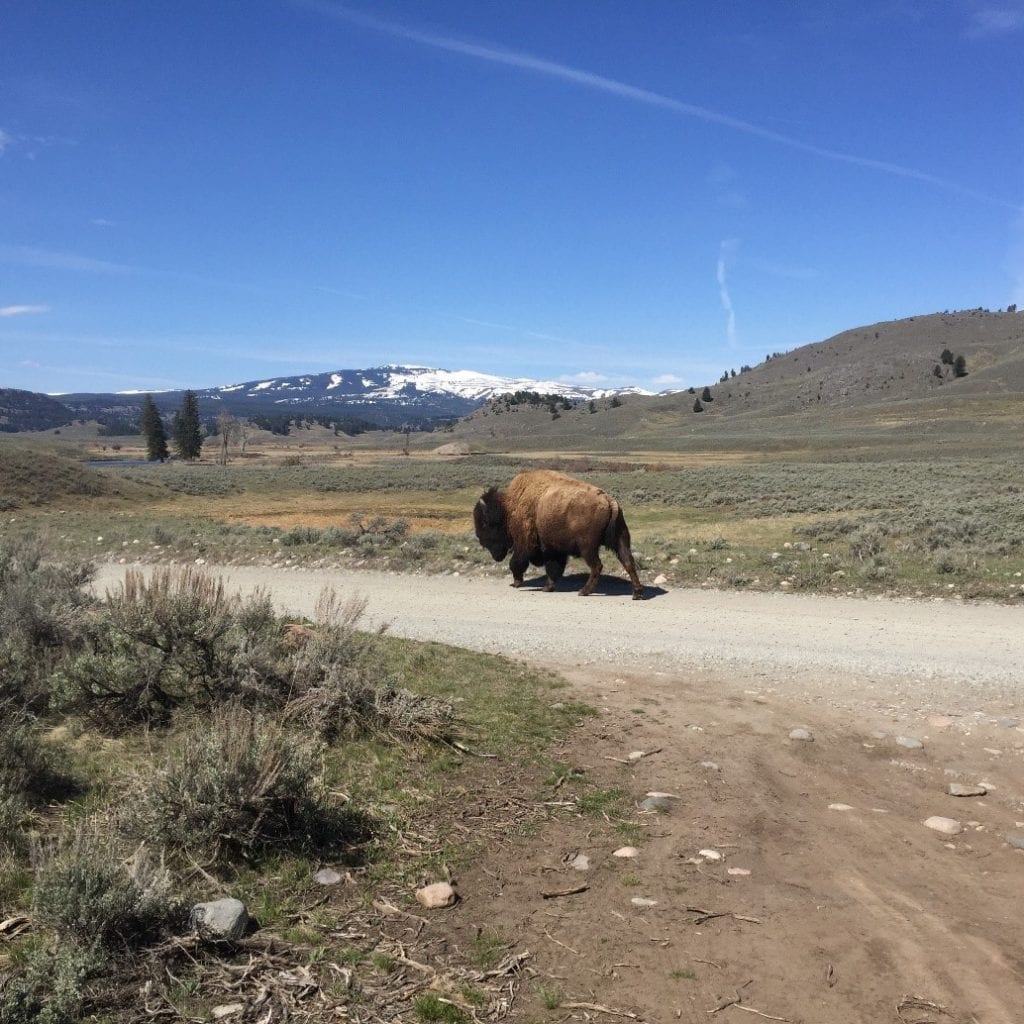
The wolves responded dramatically. One pack, the Druids, reached over 40 members before breaking up. In the years since, total wolf numbers in the park have varied from around 170 in 2003 to around 70 – 90. But with a subsequent cascade of effects forcing change throughout the park, the results of reintroduction on the wider ecology have led to Yellowstone entering ecological lore.
Elk numbers reacted almost immediately to the reintroduction and numbers are now around four thousand. This has resulted in more food for bison and other herbivores. There have also been increases in both plant and animal food sources for bears and, via the killing of coyotes by wolves, an increase in the number of pronghorn antelope. Trees such as cottonwood and aspen have flourished as elk numbers reduced. The return of the wolf has also coincided with a return of the beaver to areas from which they had previously been absent, leading to greater structural diversity in aquatic habitats. While the mechanisms underpinning the improvement in beaver numbers are not as simple as suggested in the famous video, “How Wolves Change Rivers”, there has been a widespread positive response across all trophic levels in the park, including beaver.

Our visit
To maximise our ability to see wolves and enjoy science led discussions with individuals working within the park we signed up for a wolf and bear discovery program with the Yellowstone Forever Institute (www.yellowstone.org). Our guide was Garrett Tovey, a bear biologist with a slightly jealousy-inducing range of experience with large carnivores from northern temperate zones, but any envy was mitigated greatly by his willingness to share this knowledge (and his excellent sandwiches!).
First, we had to get from the outside world to our base at Mammoth Springs. As we entered Yellowstone by the west gate heavy snow was falling. It was still winter in Yellowstone, with only the west and north entrances open. Within five miles we had our first bear, a black bear grazing by the roadside with the resulting blurred images testament to the excitement this provoked. Soon we were surrounded by bison wandering along the roads, epic views and enjoying lunch along the Madison river while watching a pair of osprey build a nest. By the time we reached Mammoth Springs we had seen elk, pronghorn, sandhill cranes, an American kestrel, chipmunks, marmots and red-tailed hawks.
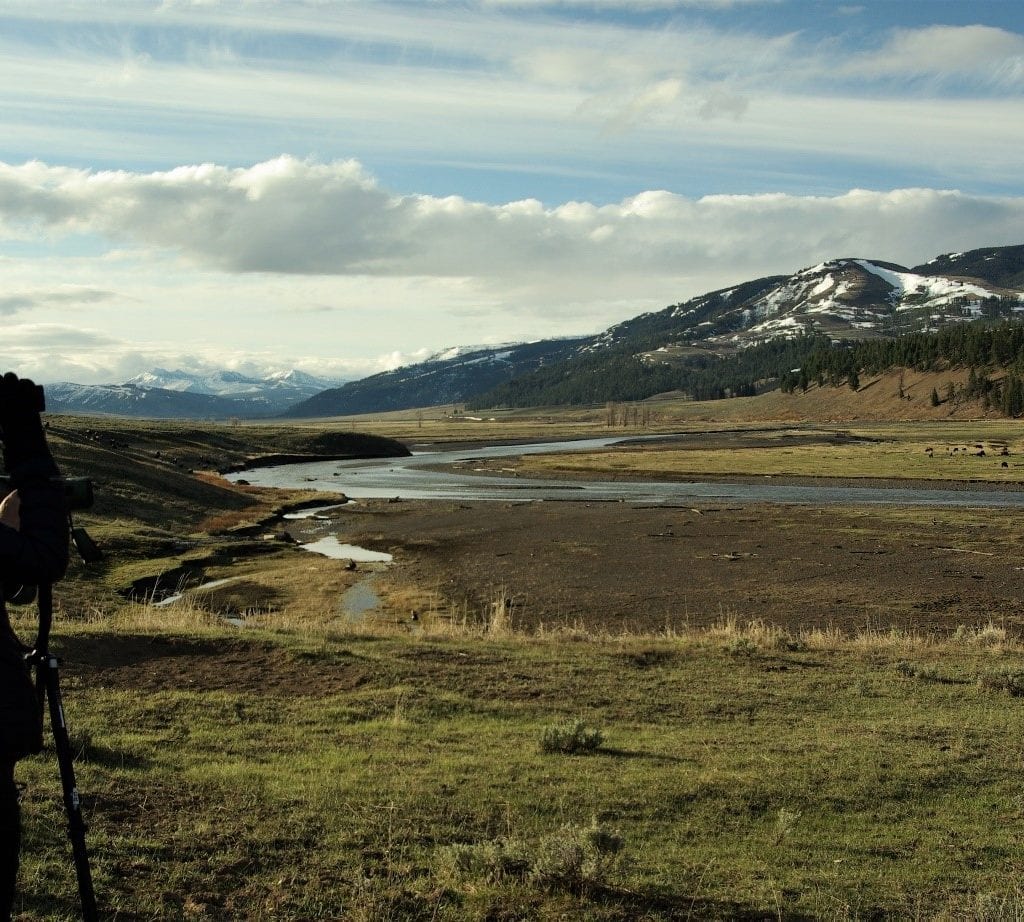
Our first full day scoping for wildlife seen us arrive at a den site for the Junction Butte wolf pack. This is well established pack of 11 wolves, and it was hoped that the presence of pups within the den would allow us a view of the group members. Very soon my first wild wolf trotted into view, carrying a pup. It was 969F, a female which alternately shares breeding rights with her sister, 907F (the latter was this year’s breeding female). A darker yearling wolf was also present.
Following the excitement of our first wild wolves, we moved further into the Lamar valley, where we soon found a female grizzly with two yearling cubs. We watched the bears for some time before moving in search of more action. It wasn’t long coming. At a recent adult bison kill site, we found three other members of the Junction Butte pack. Further up, at the very edge of the Junction Butte pack territory we found a dark yearling wolf which had just brought down a bison calf (called red dogs because of their ginger coats). After a standoff, a bison drove her off the kill, but she kept returning only to be charged repeatedly by the bison. Eventually the bison moved on as other herd members left the area. It was subsequently revealed that this wolf was from the Lamar Canyon pack and was definitely trespassing on Junction Butte territory! We finished the day spotting mountain goats sunning themselves on Baronette Peak. Later that evening while hiking the Beaver Ponds trail a black bear took exception to our presence. Slightly more terrifying than seeing a badger on the trail!
The second day brought some sad news. 969F had not been moving the pup to a new den site but had been observed eating it and several more pups. The cause of this behaviour is not known, however the discussion that morning centred on possible motives. Firstly, the complex and fluid breeding relationship between 907F and her sister 969F could have underpinned the behaviour. Another possibility is that the Junction Butte pack is approaching the “golden rule” number of maximum pack size, 12 – 14 wolves, after which packs splinter. This behaviour may have been a response triggered by pack size. Finally, the pups may have died of other causes and were subsequently eaten.
As we moved further into Junction Butte territory, we seen two black bears. One was resting against a tree while another, cinnamon morph, black bear was busy investigating cars, a behaviour very much discouraged by the park and not helped by individuals getting out of their cars close to the bear. Unfortunately, the outlook for this bear may not be good, and is a salutary reminder that even if human action is at fault, it is usually the bear facing the consequences.
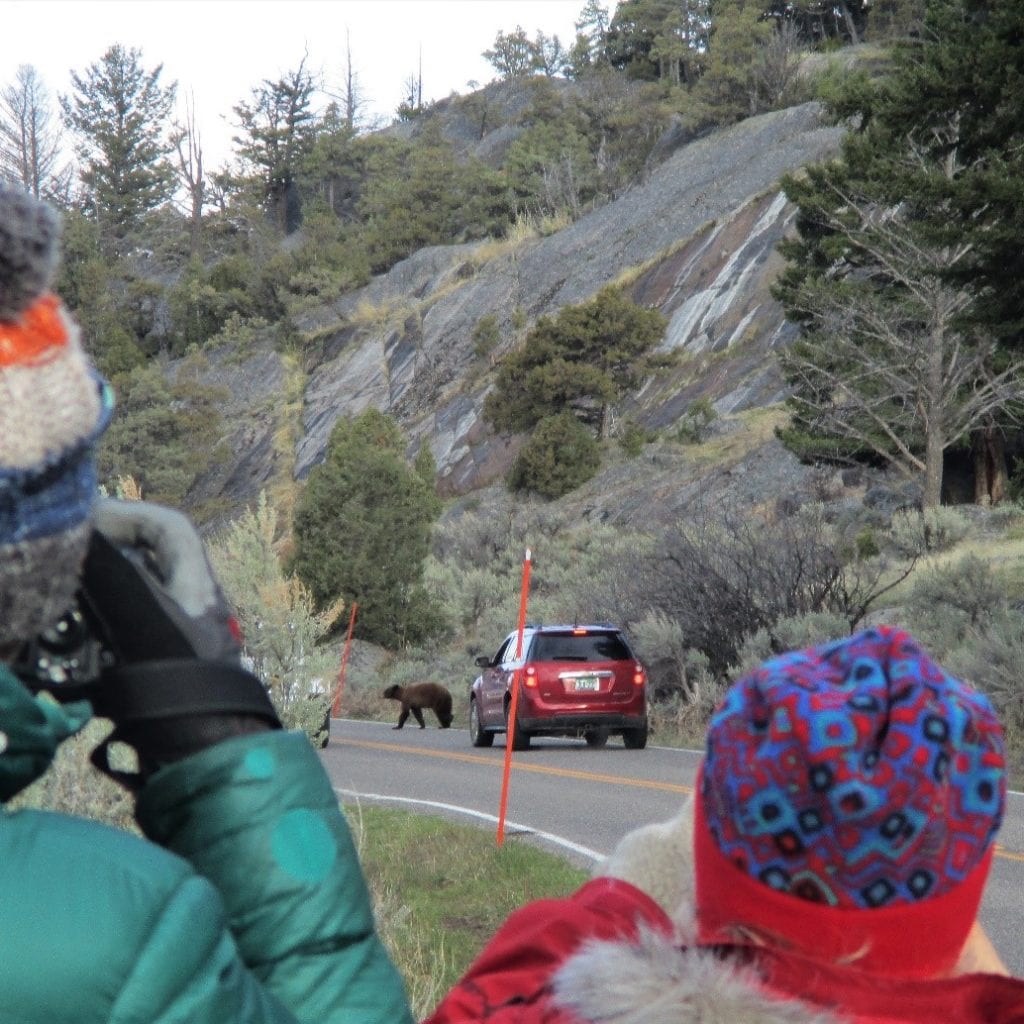
After watching some ospreys mate, we moved back to the adult bison kill site, which had been occupied by an enormous dark male grizzly bear. Four wolves from the Junction Butte pack were also present along with a young male grizzly and coyotes. After approaching the kill, the wolves settled down out of range of the bear and waited for it to move off, forming the head of the queue with the other bear and coyotes behind. When the big grizz moved off the wolves moved in, only to be scattered by the returning grizzly. After a short while he decided he had somewhere else to be which allowed the wolves to move in for a longer period. We finished the day with a guided hike along part of specimen ridge, this time interrupted by a female black bear with three Cubs of Year (COYs).
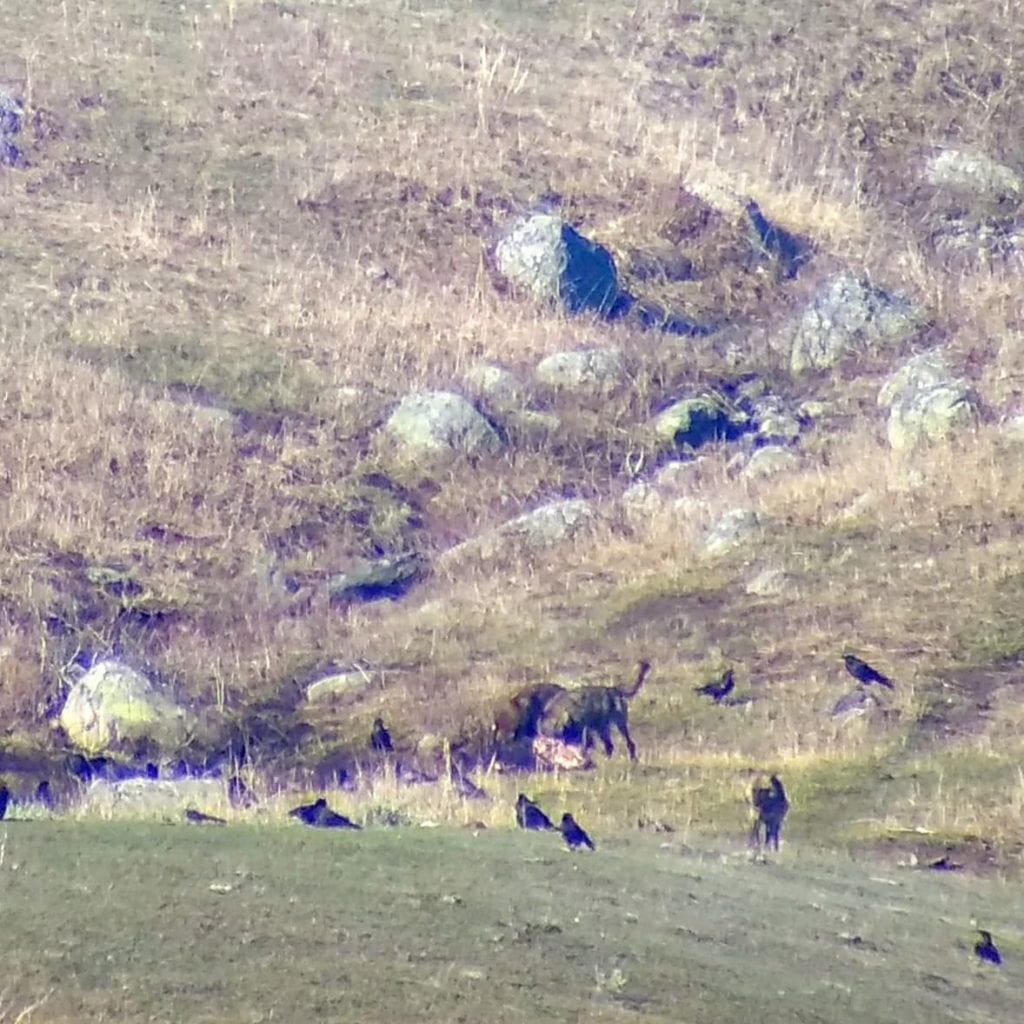
On our last day with the program we returned to the adult bison kill site. We were informed that the young grizzly had finally managed to get to the kill only to be driven off by coyotes, an event which demonstrates how hard survival can be for young bears after they leave their mother. Another interesting event occurred over the kill, with the young Lamar Canyon female from day one observed feeding with members of the Junction Butte pack. Wolves are rarely tolerant of members of other packs, and an attack would have been more likely. However, although uncommon, wolves can switch packs and the presence of such an effective young hunter could be seen as an asset. However, considering the events of the week within the Junction Butte pack, there may be some changes coming. Additionally the Lamar Canyon pack had been undergoing a major decline, falling from nine wolves in 2015 to only four in 2019 as outbreaks of mange, canine distemper, a death from another wolf pack and being shot when leaving the park prevented successful breeding recruitment and reduced adult numbers, so it may be that the young female feels it’s time to jump ship. After a check of a golden eagle nest site where we seen a juvenile golden eagle along with two bald eagles and a male bighorn sheep, we hiked to the den site of one of the first wolves to breed in Yellowstone, an outstanding way to end the program.
Before heading south to enjoy the wider Greater Yellowstone Ecosystem, we travelled into the Hayden valley the next day. Here we seen a lone wolf – possibly from the Mollies, a large aggressive wolfpack which hunts bison and is well known for raiding other pack territories and killing resident wolves – a male grizzly and several eagles. And of course, ospreys.
The most striking aspect of Yellowstone was not that we saw so many large animals and carnivores, but that we observed so many behaviours and interactions. The killing of the Junction Butte pups, the contest between the wolves and grizzly at the large bison kill and the adventures of the young Lamar Canyon female wolf were the stand-outs; but the supporting cast of coyotes fighting, ospreys mating and nest building, red-tailed hawk displays and the general abundance of life was extremely rewarding. The behaviours were expertly contextualised by our guide, who also provided roadside classroom sessions on wolf and bear biology with the help of pelts and skulls, as well as detailed descriptions of the data collection being carried out by park staff and partner organisations, highlighting the importance of long-term data when investigating ecological responses to reintroductions and restoration. This importance is borne out by such fantastic studies as the identification of an ‘old warrior’ effect within packs, where packs with older wolves can outfight larger groups without these more experienced individuals; and the exciting possibility that wolves and raven’s hunt co-operatively while recognising individuals of the other species.
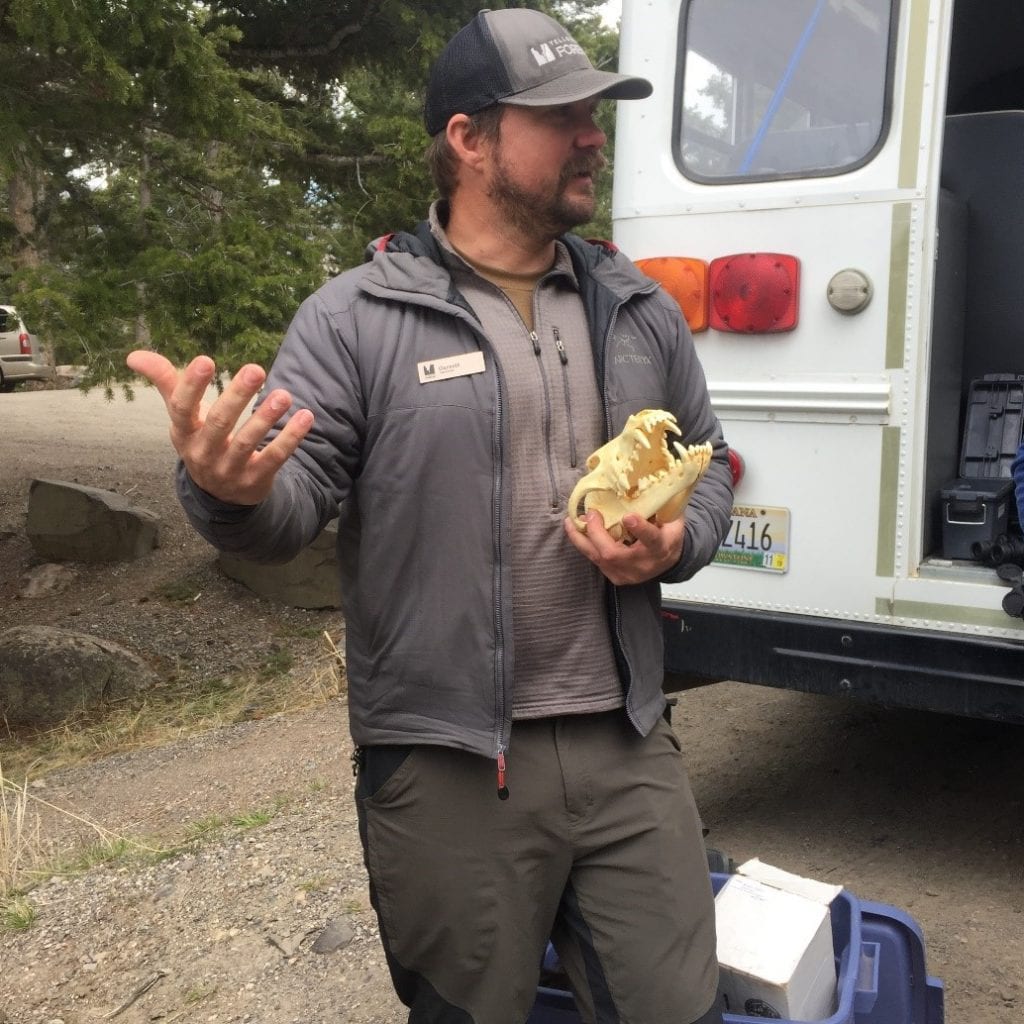
Of all the animals we had hoped to see, only the cats, beaver and moose were missing after five days. The cryptic nature of cat species means that we would have been incredibly lucky to see them, while moose are often higher up until summer. We did see some beaver ponds, but it wasn’t until Grand Teton National Park (still within the GYE and to where we subsequently travelled) that we finally recorded a beaver. Beaver are still recovering from their widespread decline; although the lack of beaver dams compared with other parks we travelled through suggests this recolonization was ongoing, or we simply looked in the wrong places.
Yellowstone – ecological perfection?
Unfortunately, no. Despite the sights we were privileged to witness, Yellowstone is not without its problems. Two percent of the park area is developed, and while this is obviously a benefit to the park wildlife, the park infrastructure is struggling to deal with the almost five million visitors. From speaking with other tourists and during discussions within our program group, it is clear that access to lodgings and dodging the crowds in summer is an issue for many, and the possibility of restrictions on entry has been mentioned. However, it is worth noting that only two percent of visitors travel more than 100 yards from the road, and by loading up with your pack and bear spray you can be alone in five minutes on a trail – well, alone from humans anyway.
The park also suffers from many of the common issues effecting environments worldwide. Climate change is beginning to exert an influence, with pika in particular at risk as change limits their accessible winter habitats. Invasive species are also an increasing problem, with 225 invasive plants recorded; but perhaps the park’s experience with an invasive fish best demonstrates how delicate a natural ecosystem can be and, just as species reintroduction can help stabilise an ecosystem, an invasive species can cause a destabilising cascade of effects just as significant as the positive benefits of wolves. Several fish species have been introduced including brown trout, rainbow trout and brook trout; but it is the lake trout that has exerted the greatest impact on its ecology, resulting in declines of swans, pelicans, cormorants, and even pressure on elk and bison populations.
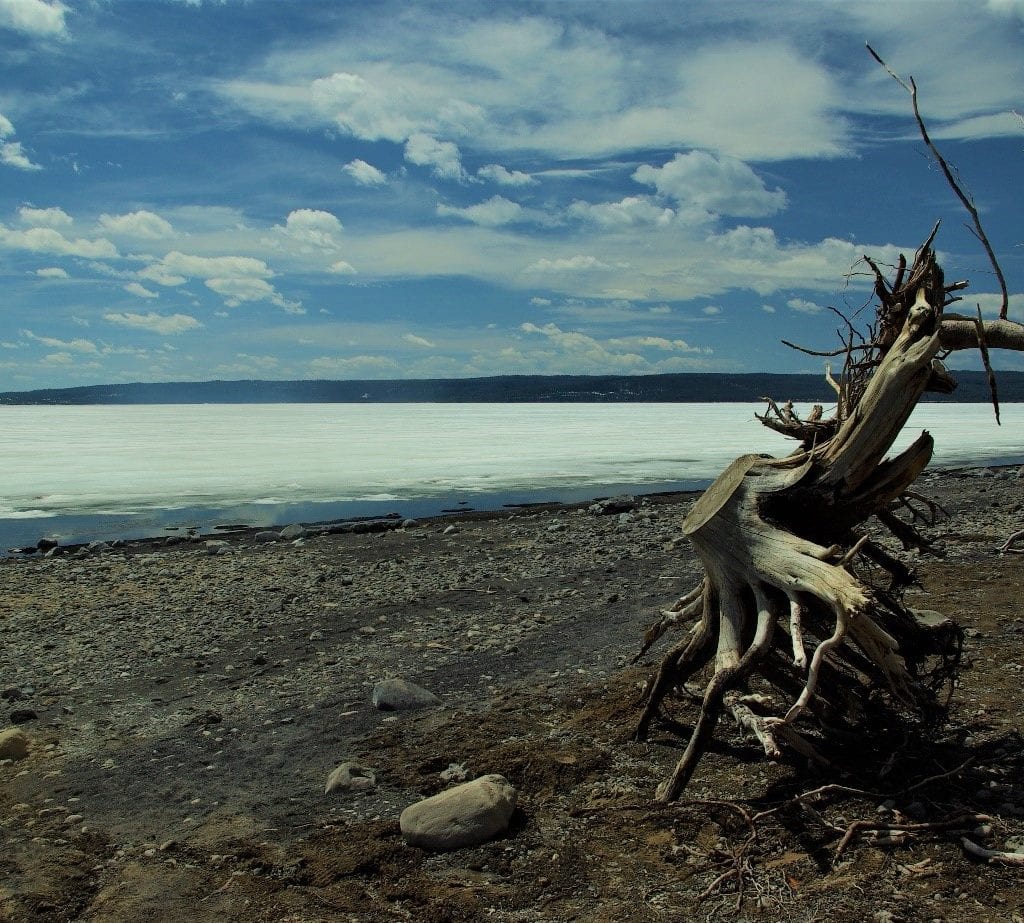
Lake trout are actually a char and were introduced to Yellowstone lake in the 1980s. The mechanism of their entry is unknown, however illegal stocking for sport fishing is believed to be the most likely cause. Subsequently this piscivorous fish has gone on to decimate native cut-throat populations, reducing available prey for eagles, ospreys and bears. Because lake trout swim deep and spawn in lakes, they have not replaced cut-throats on the menu, meaning that predators must look elsewhere. For osprey this meant a decline. In 2017 only a single chick fledged (compared with 97 in 1994). For bald eagles, predation on swan nests and attacks on flocks of ducks, pelicans and cormorants ramped up, leading to declines in abundance and productivity of the newly targeted species. Grizzlies looking to replace the protein from spring running adult cut-throats turned to young elk and bison, to the point where they now take more elk calves than wolves (2018). Measures to reduce the impact of lake trout are ongoing and starting to succeed (ospreys were very common during our trip), with gill netting programs (which removed over two million fish) and a requirement on anglers to kill all captured lake trout while returning cut-throat trout; however it is unlikely that the invasive char will ever be fully eradicated.
Final thoughts
Throughout the trip I tried to contextualise what we seen within a Scottish mindset– could we ever have such a vibrant (albeit delicate) wild ecosystem?
Although Yellowstone is only twice the size of the Cairngorms National Park, they are wildly different (pun intended). Yellowstone has never been developed; therefore, no widespread physical restoration is needed. It is not logged or planted with non-native forest; its rivers are not dammed (unless by beaver); and all large carnivores are now present. The unbroken connectivity between habitats is vital. The range needed by keystone species like wolves, which do have the potential to change the Scottish landscape, means that individual pack size and total pack numbers in our fragmented habitats in Scotland would be low, perhaps too low to allow a population to exist free from inbreeding effects.
Nonetheless the rewilding of Scotland and Europe in general is gaining momentum, and we should not dismiss the potential for a return here. Investigations carried out into the feasibility of lynx reintroduction do suggest that corridors between suitable areas of habitat for that species could be created relatively easily. It is possible, if there is a will to undertake the necessary habitat reconnections at the appropriate scales, this could be carried out for a wolf population. Habitat restoration such as in Feshie Glen and parts of Glenmore and Rothiemurchus further suggest it could happen quickly if reintroductions became policy. The benefits of wolf tourism should also not be discounted; it brings tens of millions to the local towns around Yellowstone.
But would we see the cascade of environmental effects similar to Yellowstone? That may be difficult to answer. On one hand the depressed state of our ecology suggests that anything which could bring a measure of balance back to our landscapes will have a dramatic effect; on the other the dense web of species interactions in Yellowstone is not present in Scotland due to our depressed diversity and abundances which potentially limits the range of responses. Secondly, deer overgrazing is only one part of the problem in Scotland; Yellowstone does not have issues with soil run off, wastewater treatment discharges, industrial forestry or intensive grazing by domestic animals. The lessons learned by the lake trout invasion suggest that the impacts from invasive species could be much greater here than we currently believe, and also the reduction in our salmon numbers could have a significant impact on wider Scottish ecological communities.
One thing that is clear from Yellowstone is, if we bring back our charismatic carnivores, it will be a long process. It took thirty years to take the wolf back to the wildest place in the US, and even now the politically motivated federal delisting of the wolf as an endangered species has reintroduced uncertainty to the long-term survival of the species there. The issues are complex and emotive, and perhaps time should be taken if we are to attempt reintroduction, to maximise the potential for success by building positive relationships with all stakeholders.
After everything we were lucky to see at Yellowstone I may be biased, but I definitely think we should try!
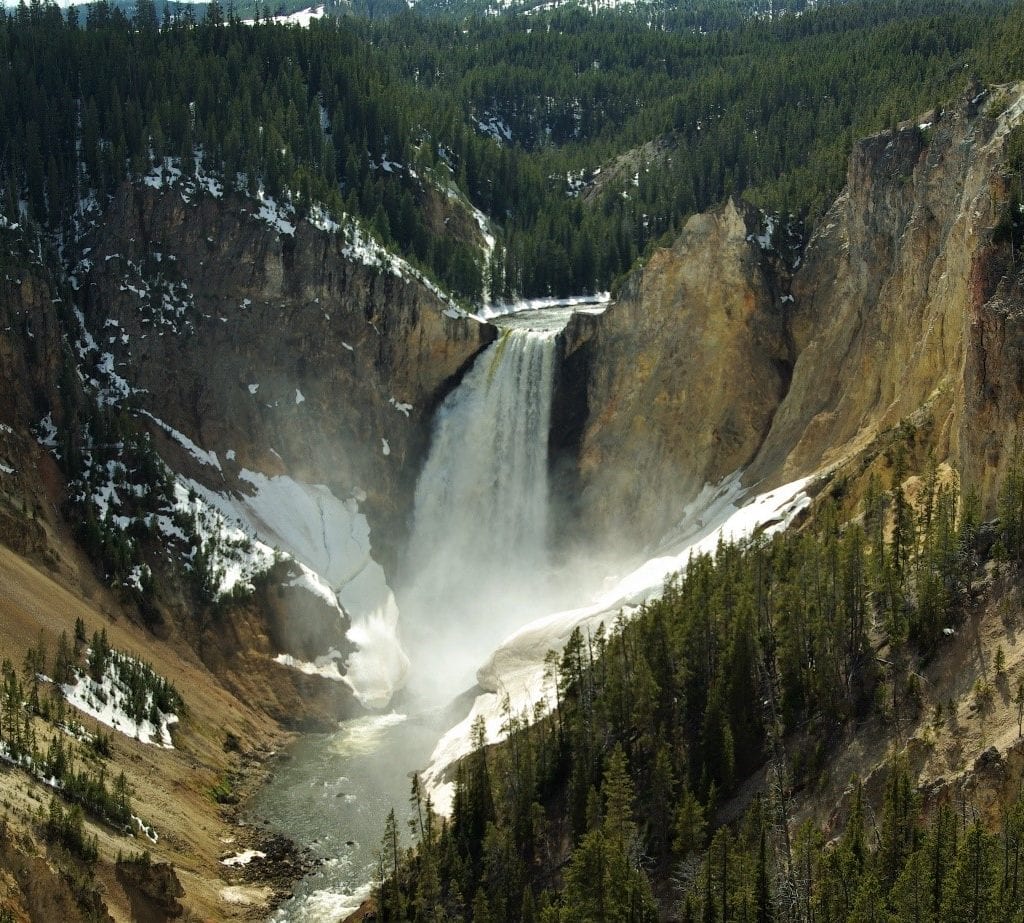
Much of this blog contains personal observation, opinion and outcomes of discussions with park guides, other tourists and individuals from within and outside the park. However, I found the following links useful when writing:
National Science Foundation. 2013. Yellowstone Ecosystem needs wolves and willow, elk and…. beavers?
NPS. 2016. Yellowstone Science: Celebrating 20 years of Wolves. Ed. D.W. Smith.
NPS. Fish and aquatic species (of Yellowstone).
Yellowstone Wolf Project Reports 1995 – 2017.
Yellowstone Reports, available for a $20 yearly fee, was used to confirm my notes from various days.
If you wish to share or discuss anything following this blog, please either use the contact form or [email protected].

